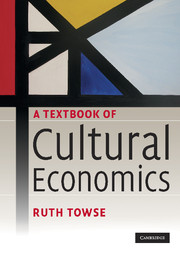Book contents
- Frontmatter
- Contents
- List of figures
- List of tables
- List of boxes
- List of abbreviations
- Preface
- Part I General issues in cultural economics
- Part II The ‘traditional’ economics of the arts and heritage
- Introduction
- 8 Economics of the performing arts
- 9 Economics of cultural heritage
- 10 Economic evaluation of cultural policy
- Part III Artists' labour markets and copyright
- Part IV The creative industries
- Part V Conclusion and exercises and problems
- References
- Index
10 - Economic evaluation of cultural policy
- Frontmatter
- Contents
- List of figures
- List of tables
- List of boxes
- List of abbreviations
- Preface
- Part I General issues in cultural economics
- Part II The ‘traditional’ economics of the arts and heritage
- Introduction
- 8 Economics of the performing arts
- 9 Economics of cultural heritage
- 10 Economic evaluation of cultural policy
- Part III Artists' labour markets and copyright
- Part IV The creative industries
- Part V Conclusion and exercises and problems
- References
- Index
Summary
This chapter explores the way cultural economists approach the evaluation of cultural policy. It does not discuss cultural policy itself but, instead, presents the way economists assess policies in general, and it focuses on particular topics on which cultural economists have written concerning cultural policy or policies. ‘Cultural policy’ is a broad term that covers a range of government interventions and initiatives to achieve objectives, such as increasing participation in the arts and culture and encouraging diversity of cultural supply, which may or may not involve public expenditure; when the use of taxpayers' money is involved, that calls for accountability to voters.
Cultural policy for the arts and heritage typically has cultural aims, though, as chapter 14 shows, there can also be a strong economic motive to some policies, especially those for the creative industries, and, moreover, policy-makers and arts organisations may choose to justify projects in terms of their economic impact. Previous chapters have already discussed the way economists evaluate specific policy issues, such as charging for entry to museums. In this chapter, however, the intention is to present the analysis in general terms, using the material of all the preceding chapters. Therefore this chapter deals with applied welfare economics, principal–agent analysis, performance indicators and economic impact studies, and I revisit the cost disease as an underlying raison d'être for subsidy to the arts and heritage.
- Type
- Chapter
- Information
- A Textbook of Cultural Economics , pp. 263 - 288Publisher: Cambridge University PressPrint publication year: 2010



